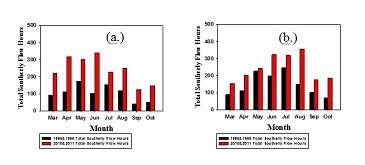Houston Findings Should Hold for Coastal Regions Around the World
Researchers at the University of Houston have determined that climate change – in the form of a stronger sea breeze, the result of warmer soil temperatures – contributed to the drop in high-ozone days in the Houston area.

Radio Interview: KUHF's Houston MattersRobert Talbot, professor of atmospheric chemistry in the College of Natural Sciences
and Mathematics, said that also should be true for coastal regions globally.
The researchers describe their findings in a paper published this week in the journal Atmosphere. In addition to Talbot, they include first author Lei Liu, a doctoral student, and postdoctoral fellow Xin Lan.
The study relied upon ground-level ozone data collected over the past 23 years by the Texas Commission on Environmental Quality. The meteorological data was collected by the National Oceanic and Atmospheric Administration.

Total southerly flow average hours in Aldine in 1990-96 (black) and 2010-2011 (red).

Days in which ozone levels in Aldine exceeded EPA standards during a one-hour period
over the past 23 years (blue line), contrasted with number of hours of southerly wind
flow (red).The researchers said they did not set out to find a connection between climate change
and lower ozone levels – the number of days in which ozone levels exceeded federal
standards varied from year to year but overall, dropped dramatically between 1990
and 2013. For example, in Aldine, one of four sites studied, the number of days during
which ozone levels exceeded federal standards over an eight-hour period dropped to
an average of 11 days per year during 2001-2013, down from 35 days per year during
1990-2000.
Talbot said the steep decline made him suspect something was happening beyond a city-led effort to reduce nitrogen oxide emissions, one of the components of ozone.
Liu said they first ruled out other meteorological factors, including temperature, humidity and solar radiation. After they discovered the lower ozone readings coincided with days the southerly flow was strongest, they realized that climate change – in the form of warmer soil temperatures – had increased the southerly flow, she said.
“The frequency of southerly (air) flow has increased by a factor of ~2.5 over the period 1990-2013, likely suppressing O3 (ozone) photochemistry and leading to a ‘cleaner’ Houston environment,” they wrote. “The sea breeze was enhanced greatly from 1990 to 2013 due to increasing land surface temperatures, increased pressure gradients, and slightly stronger on-shore winds. These patterns driven by climate change produce a strengthening of the sea breeze, which should be a general result at locations worldwide.”
Industrial plants and vehicle exhaust mix with heat and sunlight to produce ground-level ozone, which can worsen asthma and other conditions. The city’s rapid population growth – more people means more cars – and the refineries and petrochemical plants along the Houston Ship Channel are key factors in Houston’s ground-level ozone.
The U.S. Environmental Protection Agency in 1997 classified Houston as a “severe” nonattainment area due to ozone levels measured over an eight-hour period. By 2008, the city was classified as a “moderate” nonattainment area.
For the study, researchers focused on data from four locations: Galveston, Clinton Drive near the Houston Ship Channel, Aldine and a site in Northwest Harris County. They also used data on background ozone levels collected from the roof of Moody Tower, a high-rise residence hall on the UH campus.
Background ozone levels have remained constant over the past seven years, they report, dropping just one part per billion. The average background level over that period was 30 parts per billion.
But the number of days in which ground-level ozone exceeded federal standards in one-hour
and eight-hour measures dropped sharply at all four sites between 1990 and 2013. (Data
for the Galveston site is available only back to 1997.)
In contrast, “the length of time per year Houston is under the influence of southerly
flow has more than doubled from 1990 to 2013,” the researchers wrote. “ … We propose
that the increased flow of ‘cleaner’ air is diluting the dirty Houston air, lowering
the mixing ratios of NOX, O3 and precursor hydrocarbons. It also would advect the
polluted air away from Houston,” leading to lower potential to produce ozone.
They compared land and sea temperatures over the 23-year period to determine how temperature differences impact southerly flow. Land temperatures increase faster than water temperatures on a daily time scale, Liu said. As the heated air over land rises, cooler air from the sea rushes in, dispersing both ozone and the chemical elements that contribute to ozone.
“We weren’t looking at it from a climate change perspective at first,” Talbot said. “Then once we saw it was the sea breeze, we knew it had to be climate.”
- Jeannie Kever, University Media Relations